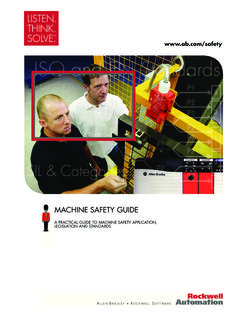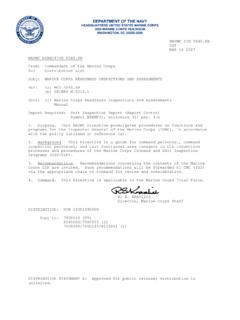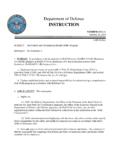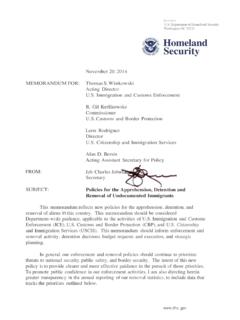Transcription of DIRECTIVE NUMBER: CPL 02-00-147 EFFECTIVE …
1 DIRECTIVE NUMBER: CPL 02-00-147 EFFECTIVE DATE: 2/11/08. SUBJECT: The Control of Hazardous Energy Enforcement Policy and Inspection Procedures ABSTRACT. Purpose: This DIRECTIVE (manual) establishes OSHA's enforcement policy for its standards addressing the control of hazardous energy. It instructs OSHA. enforcement personnel on both the agency's interpretations of those standards, and on the procedures for enforcing them. The application of this instruction will further OSHA's goal of uniform enforcement of these standards. However, OSHA personnel should exercise professional judgment consistent with their authority as appropriate when particular circumstances necessitate a deviation from the guidance provided in the instruction in order to effectuate the purposes of the occupational safety and health Act (OSH Act), to utilize resources to effectively administer the OSH Act, or to ensure CSHO safety .
2 This instruction is not a standard, regulation or any other type of substantive rule. No statement in this instruction should be construed to require the regulated community to adopt any practices, means, methods, operations, or processes beyond those which are already required by the OSH Act or standards and regulations promulgated under the OSH Act. Scope: This instruction applies OSHA-wide. References: 1. General Industry Standards, 29 CFR Part 1910. 2. Federal Register, Vol. 54, No. 169, September 1, 1989, pages 36644- 36696, Control of Hazardous Energy Sources (Lockout/Tagout), Final Rule, 29 CFR 3. Federal Register, Vol. 55, No. 183, September 20, 1990, pages 38677- 38687, Control of Hazardous Energy Sources (Lockout/Tagout), Final Rule, Corrections and Technical Amendments, 29 CFR 4.
3 Federal Register, Vol. 58, No. 59, March 30, 1993, pages 16612- 16623, Control of Hazardous Energy Sources (Lockout/Tagout), Final Rule, Supplemental Statement of Reasons, 29 CFR 5. Federal Register, Vol. 65, No. 119, June 20, 2000, pages 38302-38304, Control of Hazardous Energy Sources (Lockout/Tagout), Notice of the Availability of a Lookback Review Pursuant to the Regulatory Flexibility Act and Executive Order 12866. Cancellations: OSHA Instruction, STD 01-05-019 [STD ], 29 CFR , The Control of Hazardous Energy (Lockout/Tagout) -- Inspection Procedures and Interpretive Guidance, September 11, 1990. As part of the DIRECTIVE revision process, OSHA has removed and archived interpretations from its public web-site that no longer reflect current policy and/or are superseded by this OSHA Instruction.
4 State Impact: This instruction describes a Federal Program change for which State adoption is not required, but is recommended. (See Chapter ). [State Adoption Summary]. Action Offices: National, Regional, Area, and State Consultation Offices. Originating Office: Directorate of Enforcement Programs, Office of General Industry Enforcement Contact: Directorate of Enforcement Programs (202-693-1850). Office of General Industry Enforcement 200 Constitution Avenue, , N-3119. Washington, DC 20210. By and Under the Authority of Edwin G. Foulke, Jr. Assistant Secretary Abstract-2. Executive Summary This DIRECTIVE (manual) provides guidance to OSHA personnel concerning the occupational safety and health administration 's (OSHA's) policy, procedures, and technical interpretations regarding the enforcement of the Control of hazardous energy (lockout/tagout) standard, 29 CFR.
5 , and other related standards. OSHA completed a look-back review of its Control of hazardous energy (lockout/tagout) standard, 29 CFR , pursuant to Section 610 of the Regulatory Flexibility Act and Section 5 of Executive Order 12866. In response to the look-back review's suggestions, OSHA Instruction STD 01-05-019 [STD ], 29 CFR , The Control of Hazardous Energy (Lockout/Tagout) Inspection Procedures and Interpretative Guidance (dated September 11, 1990) has been cancelled and superseded by this instruction. However, due to the magnitude of this review, a phased approach is planned for the revision of this instruction. Many of the changes contained in this revision are described below, and the second phase will include the incorporation of existing letters of interpretation, including frequently asked questions, into the manual.
6 Significant Changes This instruction cancels the September 11, 1990 OSHA Instruction, STD This manual provides enforcement policy and guidance for OSHA personnel performing inspection activity related to the control of hazardous energy. Significant modifications in this instruction include: Changes in the instruction format necessitated by the OSHA DIRECTIVE System (ADM 03- 00-003);. Addition of Compliance Officer safety guidelines;. Inclusion of Citation Examples and additional guidance regarding Affirmative Defenses;. Incorporation of compliance assistance flowcharts;. Inclusion of additional guidance on the minor servicing exception, specific energy control procedures, periodic inspections, and unexpected energization;. Inclusion of additional information and guidance on Alternative Methods to Lockout/Tagout (LOTO).
7 Inclusion of general reference material for information pertinent to hazardous energy control, including governmental, industry and national consensus standards; and Addition of vehicle repair and maintenance standards and practices, including relevant Internet links, to assist employers engaged in these activities with hazardous energy control. Abstract-3. Table of Contents Chapter 1 BACKGROUND .. 1-1. I. Purpose .. 1-1. II. Scope .. 1-1. III. Significant Changes .. 1-1. IV. Cancellations .. 1-1. V. 1-1. VI. Action .. 1-3. VII. Federal Program Change .. 1-3. VIII. Standard Overview .. 1-3. IX. Definitions .. 1-4. A. Affected 1-4. B. Authorized Employee .. 1-4. C. Capable of Being Locked Out .. 1-5. D. Control 1-5. E. Controller .. 1-5. F. Disconnecting Means.
8 1-5. G. Energized .. 1-5. H. Energy Isolating 1-5. I. Exclusive 1-6. J. Group 1-6. K. Group Lockout/Tagout Mechanism .. 1-6. L. Hazardous Energy .. 1-6. M. Hot Tap .. 1-7. N. Isolating 1-7. O. Job Lock ( Operations or Production Lock ).. 1-7. P. Job-Tag with a 1-7. Q. 1-7. R. Lockout 1-8. S. Lockbox (Master).. 1-8. T. Lockbox (Satellite).. 1-8. U. Machinery and Machine Guarding (29 CFR Part 1910, Subpart O).. 1-8. V. Master Tag .. 1-8. W. Normal Production Operations .. 1-8. X. Personal Tagout (Accountability) Device .. 1-8. Y. Primary Authorized 1-9. Z. Principal Authorized Employee .. 1-9. AA. Safeguarding .. 1-9. BB. Servicing and/or 1-10. CC. Setting 1-10. DD. Tagout .. 1-11. EE. Tagout device .. 1-11. FF. Work Authorization 1-11. X. Terminology.
9 1-11. i Chapter 2 ENFORCEMENT POLICIES AND 2-1. I. Compliance Officer safety .. 2-1. II. Inspection Guidelines .. 2-3. A. Performance of Servicing or Maintenance Operations .. 2-3. B. Employer 2-3. C. Evaluations of Compliance .. 2-3. D. Documentation and Screening Guidance .. 2-4. E. Outside Personnel .. 2-7. F. Compliance Assistance 2-7. III. Citation Guidance .. 2-7. A. General .. 2-7. B. Classification of 2-11. C. Citations in the Alternative .. 2-11. D. Citation Examples .. 2-11. IV. Alternative Methods and Consensus 2-15. A. General .. 2-15. B. Minor Servicing Exception to the Lockout/Tagout Standard .. 2-16. C. 29 CFR 1910, Subpart O, Machinery and Machine Guarding.. 2-16. D. Consensus 2-22. E. Energy Isolating Device Equivalency .. 2-27.
10 F. Other Abatement Methods .. 2-30. V. Multi-employer Scenario .. 2-31. VI. Affirmative 2-32. A. Greater Hazard .. 2-32. B. 2-32. C. Unpreventable Employee Misconduct and Isolated 2-33. Chapter 3 INSPECTION GUIDANCE .. 3-1. I. Purpose of the Standard .. 3-1. II. Scope and Application of the Standard .. 3-2. A. Unexpected Energization, Unexpected Start-up, and Release of Stored Energy3-2. B. Normal Production Operations .. 3-6. C. Lockout/Tagout's Relationship to Other OSHA Standards .. 3-8. D. Standard Exemptions .. 3-16. E. Compliance Assistance 3-17. III. Vehicle Hazardous Energy Control .. 3-22. A. Background .. 3-22. B. Hazardous Energy .. 3-22. C. Energy Control Program .. 3-23. D. Manufacturers' Servicing and Maintenance Guidelines .. 3-24.
















